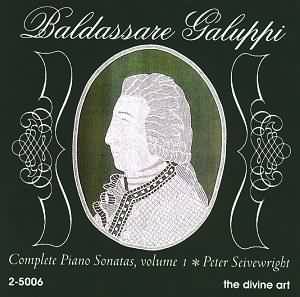
This is a fascinating disc and the beginning of a very important project
in which Peter Seivewright is to record all 90 of Galuppi's keyboard sonatas
and endeavour to publish them so that we can perform them too.
What makes this project so important is that it is a pioneering undertaking.
There is no performing tradition in Galuppi sonatas as there is in say Scarlatti
or Bach. Mr Seivewright has to establish a performing tradition in effect.
He has already conducted detailed research in Venice and has been shocked
at comparing manuscripts of the sonatas and unearthed endless copyist errors.
It is clear that his dedication to this task is similar to Ralph Kirkpatrick's
commitment to the Scarlatti sonatas.
The Galuppi manuscripts do not give clear indications as to tempo, dynamics,
ornamentation and character. As you will see the sonatas are not numbered
and on this disc you have two in A minor and two in C minor. The work of
cataloguing and editing will take some time.
Some of the sonatas have a baroque feel while others approach early Beethoven
as you might expect from Galuppi's time (1706 - 1785). His music is very
tuneful, unpretentious and untrammelled by 'early music fussiness'. They
are far more appealing that Scarlatti sonatas.
I have to commend the recording engineer on this disc, Douglas Doherty who
produces a close, intimate and crisp sound.
As to the sonatas ....
Sonata in A minor
Here Peter Seivewright gives us a splendid example as to how to play
cantabile which all students and fellow pianists would do well to
emulate. The opening movement is tuneful and coherent, expertly realised
with colour and a very sensitive performance. The tempo is expertly
judged. The allegro vivace is an engaging movement with welcome contrasts
and displays clear and reliable finger work.
Sonata in C minor
The expressive cantabile is again present in adagio molto.
There is some exquisite imitation. And the darkness of C minor that one usually
associates with Mozart and Beethoven is here. It is often very beautiful.
The allegro has clear form and, again, is very tuneful. The choice
of ornamentation is excellent and adds to, rather than distorts the sheer
melodic joy.
Sonata in B flat
This begins with a long andantino movement full of melodic invention and
played with superb sensitivity. Even scales sound fresh and original. The
allegro is playful.
Sonata in C minor
This is a three movement work. A descending arpeggio figure is one of its
many features. the allegro is both captivating and contagious and,
yet again, there is a melody that sounds 'mountain fresh'. The final allegro
assai seems to stutter a little.
Sonata in A
The andante is a good piece and improves with further listening. It
takes an exceptional composer to so cleverly develop what appears to be scant
material. There is a final allegro.
Sonata in G minor
The substantial opening largo is a fascinating inner quest by the
composer. The allegro energico is fugal in character and makes compelling
listening. The final allegretto grazioso has a courtly but not affected
elegance and the performance is infused with a splendid variety of tone and
colour.
Sonata in E
This is an allegro followed by variations, and splendid they are.
Again the performance is one of reliable finger work and great sensitivity.
Sonata in F
A long slow movement begins with tremendous beauty and develops into exciting
energy. The thoughtful finale may surprise a few listeners.
The 'sleeve booklet' gives an excellent introduction to the life and times
of this gifted composers and whets our appetite for further helpings.
Highly recommended
Reviewer
David Wright
Performances

Recording

and Peter Grahame Woolf says
This CD heralds an ambitious project, backed by the player's liner notes
which are headed The life and times of Baldassare Galuppi (1706-1785)
part one. Peter Seivewright is an experienced pianist with international
appearances and many CDs under his belt (Nielsen for Naxos; Romantic
Danish Piano Music for Rondo, etc).
He claims 'dazzling height' for Galuppi's works for the newly established
piano, in Seivewright's view 'the greatest musical instrument ever
invented', then establishing its pre-eminence in Venice and quickly
supplanting harpsichord and clavichord. (I'll have more to say about
that elsewhere!) He claims Galuppi's sonatas as his greatest contribution
to the history of musical composition. I find those claims questionable
and much of the music, in these performances on a modern concert grand,
dull and uninspiring.
In expert hands music of the period can sound fine on today's pianos (e.g.
Scarlatti played by Mikhail Pletnev is unalloyed delight; I know no better
way to start the day than with a few of them - Virgin
VCD5
45123-2) but neither Galuppi nor Seivewright are in that class.
The project (10 CDs featuring 90 sonatas) seems possibly misconceived.
It might have been prudent to have trawled the series to taste the water
by starting with a sampler, selecting some of the better sonatas, and
then to consider more appropriate instruments for future releases?
Reviewer
Peter Grahame Woolf

